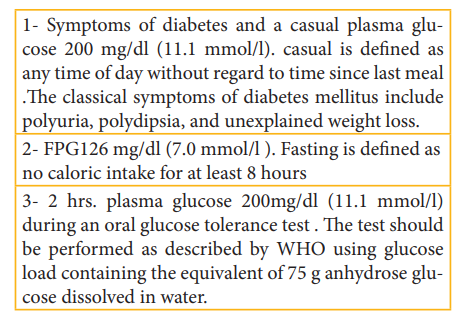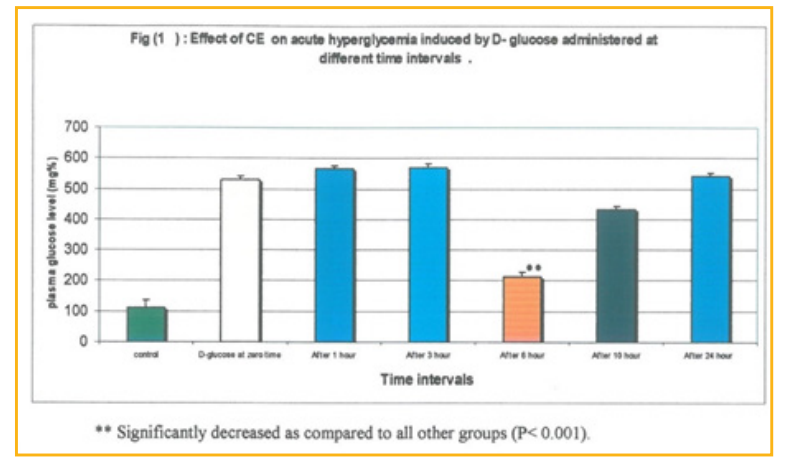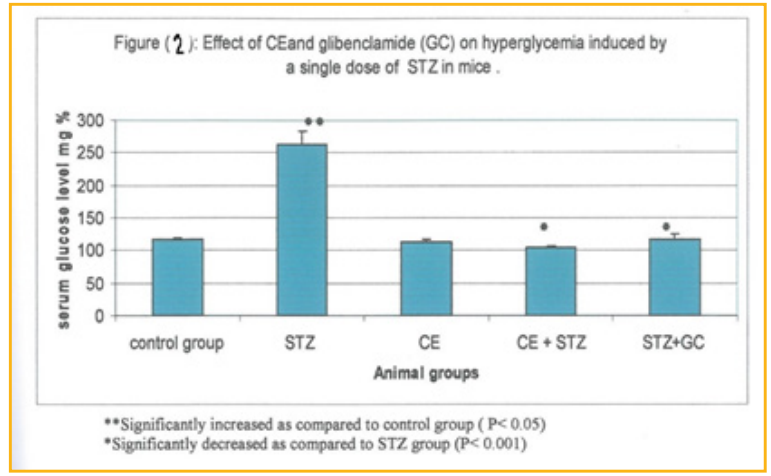Author(s): Samia Elzwi* and Hamida ALbarasi
Cinnamon is a small evergreen tree 10-15 meters tall, belongs to the family Lauracae. The leaves are ovate-oblong in shape, 7-18 Cm long, the flowers which are arranged in panicles, have greenish color and distinct odor. The fruit is a purple one centiberry containing a single seed. Cinnamon are widely used as spice and flavoring agent and can be clinically used in treatment of certain diseases such as type 2 diabetes mellitus. Cinnamon extract has blood glucose lowering effect in patients with type 2 diabetes. This study tested the effect of cinnamon extract on D- glucose induced hyperglycemias which showed significant reduction in plasma glucose level. Chronic hyperglycemia model induced by a single intraperitoneal injection of streptozotocin, the extract showed marked decrease in blood glucose level.
Diabetes mellitus is disease characterized by hyperglycemia it is associated with relative or absolute impairment in insulin secretion, along with varying degree of resistance to the action of insulin.
The American Diabetes Association (ADA) issued diagnostic criteria for diabetes mellitus in 1997 with follow up in 2003. The diagnostic criteria is based on one of three following abnormalities: fasting plasma glucose, random elevated glucose with symptoms, or abnormal oral glucose tolerance test as shown in (Table 1) [1]. the 2003 criteria lowered the fasting plasma glucose level used to define impaired fasting glucose (IFG) from the 1997 criteria but maintained the same definitions for diabetes and impaired glucose tolerance (IGT) as measured by an oral glucose tolerance test. Patients with IFG and / or IGT are now referred to as having pre-diabetes indicating the relatively high risk for development of diabetes in these patients.

Table 1: Criteria for diagnosis of diabetes mellitus
There is two types of diabetes type 1 is characterized by destruction of the pancreatic B cells leading to absolute insulin deficiency. This is usually due to autoimmune destruction of B pancreatic cells (Type 1A).
Testing for Islet- cell antibodies (ICA) or other autoantibodies (antibodies to glutamic acid dehydrogenase [ant-GAD] and anti-insulin) in serum may be helpful if establishing the diagnosis is important: a positive result is indicative of type1A diabetes. However, some patients have no evidence of autoimmunity and have no other cause for beta cell destruction (idiopathic type 1B diabetes mellitus [2].
Type 2 diabetes is responsible for over 80% of cases of diabetes in the United states, Canada, and Europe. Type 1 diabetes accounts for another 5 to 10 %, with the remainder due to other causes. New information has led to increased understanding of genetic defects related to diabetes, and the formerly termed MODY syndrome (maturity onset diabetes of the young) have now been linked to specific genetic defects [3].
Cinnamon has been known from remote antiquite, and it was so highly prized among ancient nation that it was regarded as a gift for monarchs and other great potentates. It was imported to Egypt from China as early as 2000BC [4]. In the middle Ages, the source of cinnamon was a mystery to the Western world Arab traders brought the spice via overland trade route to Alexandrai in Egypt, where it was bought by Venetian traders from Italy who held a monopoly on the spice trade in Europe [5]. Its flavor is due to an aromatic essential oil which makes up 0.5 to 1% of its composition.
This oil is prepared by roughly pounding the bark, macerating it in the sea – water, and then quickly distilling the whole [6]. It is of a golden yellowish color with characteristic odour of cinnamon and a very hot aromatic taste. The pungent taste and scent come from cinnamic aldehyde or cinnamaldehyde and by the absorption of oxygen as it ages, it darken color and develops resinous compounds.
Chemical compostion of essential oil include ethyl cinnamate, eugenol, cinnamadehyde, beta- caryophyyllene, linalool and methyl chavicol [7]. Cinnamon leaf oil has a warm, spicy, but rather harsh odour, lacking the rich body of the bark oil [8].
Its mjor constituents is eugenol rather than cinnamaldehyde, It’s used as flavoring agents for seasoning and savory snaks. As a cheap fragrance it is added to soaps. The oils high eugenol content also makes it valuable as source of this chemical subsequents conversion into iso-eugenol. another flavoring agents.
Glucose is the most abundant monosaccharide, a subcategory of carbohydrates. The naturally occurring form of glucose is d-glucose, while l-glucose is produced synthetically in comparatively small amounts and is of lesser importance. Glucose is a monosaccharide containing six carbon atoms and an aldehyde group and is therefore referred to as an aldohexose (C6h42O6) [9].
Streptozotocin (STZ, 2- deoxy-2- (3 methyl 3- nitrosoureido) D – glucopyranose) is synthesized by streptomycetes achromogenes and is used to induce both insulin dependent and non – insulin dependent diabetes mellitus (IDDM and NIDDM respectively). The frequently used single intravenous dose in rat to induce IDDM is between 40- 60 mg/kg b.w, but higher dose are also used [10]
Dried cinnamon park was obtained from the local market, crushed by using electrical crusher to obtain the powder .The solvent extraction was performed by using petroleum ether, chloroform, ethyl acetate, ethanol and distilled water to get the aqueous extract of the plant. This was done by using continuous percolation process and the method used for this, was soxhelt apparatus extraction [11].
500 grams of coarse plant powder were put in the thimble siphons of soxhelt after maceration in the same solvent for 15 minute, the flask of sexhelt was filled with about one liter of the used solvent and heating of solvent was started at temperature 60-80 C°. And by condensation process the solvent in the thimble siphons off into main vessel containing the extract. The process continued for 4-5 times until complete extraction was achieved. The solvent from the flask was evaporated by using the rotatory evaporator under vacuum at temperature of 40-50 C° and rotation was continued until the extract of specific solvent was obtained.
The extraction process started by using solvent with less polarity and gradually increasing the polarity with other solvents as follow.
Petroleum ether, chloroform, ethyl acetate, ethanol and water after complete extraction with each solvent, the plant powder was removed from soxhelt apparatus and kept at room temperature exposed to atmospheric air until it was dry the soaked with other next solvent according to planned order. Finally 20 grams of dry powder were obtained from each complete extraction cycle, the percent of yield was 4%.
Male albino mice were used, animals were divided into seven groups each of six animals. The first group was control group it was treated with normal saline (0.2 ml/mouse I.P). The second group was given a single dose of D – glucose (10 g/kg, IP) it was the positive control group [12]. The third, fourth, fifth, sixth and seventh groups were treated with single dose of cinnamon extract (300mg/kg PO) at same time. Later on these five groups were injected by D - glucose (10 g/kg IP) ad different time intervals from the treatment with cinnamon estimated in all animal groups by using Accu- cheek glucose test strip this was by piercing the tail of the mice, a drop of blood was placed on a blood glucose test strip which then inserted into glucose meter.
Male albino mice were used, animals were divided into seven groups each of six animals. The first group was control group it was treated with normal saline (0.2 ml/mouse I.P). The second group was given a single dose of D – glucose (10 g/kg, IP) it was the positive control group [12]. The third, fourth, fifth, sixth and seventh groups were treated with single dose of cinnamon extract (300mg/kg PO) at same time. Later on these five groups were injected by D - glucose (10 g/kg IP) ad different time intervals from the treatment with cinnamon extract at 1, 3, 6,10, 24 hrs.). The blood glucose level was estimated in all animal groups by using Accu- cheek glucose test strip this was by piercing the tail of the mice, a drop of blood was placed on a blood glucose test strip which then inserted into glucose meter.
To induce diabetes female mice were injected with streptozotocin (100 mg/kg IP) streptozotocin was dissolved in 0.1 mol/L sodium citrate buffer (pH4.0) and injected within 5 minute [13]. To determine the effects of cinnamon extract mice were divided into five groups each of six animals, The first non-treated control group was given a citrate buffer (0.5 ml/mouse PO) and the third group was treated only with cinnamon extract (300 mg/kg PO) for 2 weeks (positive control group). The second, fourth and fifth animal group were fasted about 12 hours prior treatment with single dose of streptozotocin (100 mg/kg IP).
The fourth group was pretreated with cinnamon extract (300mg/kg /day PO) for two weeks prior to treatment with streptozotocin and lastly the fifth group treated with a single dose of glibenclamide (0.5 mg/kg PO) [14]. 2 hours before collecting blood on the day of sacrifice mice were kept overnight fasted then decapitated without anesthesia and trunk blood was collected into perhilled tubes containing 1 mg/ml of EDTA for insulin and glucose determination .Blood glucose was determined using glucose oxidase kit, plasma insulin was assayed using a standard radioimmunoassay technique. extract at 1, 3, 6,10, 24 hrs.). The blood glucose level was
Statistical Analysis: The result of this experiment was done by use of descriptive analysis as the mean S.E.M. Data was analyzed by using T- test in some experiment and the method of analysis of variance (ANOVA). The significant of analysis is indicated by the p value if it is equal to less than 0.05 it is considered as statistically significant.
As shown in figure (1) , the plasma glucose level at different time intervals from the administered single Cinnamon extract dose was significantly decreased after 6 hours as compared to thee all other groups ( control, zero time, at 1 hour, at 3 hour , at 10 hour and at 24 hours ) and the p value was ( p< 0.001).

Figure 1: Hypoglycemic effect of cinnamon extract on D- glucose induced hyperglycemia.
As shown in figure (2) by using ANOVA followed by post Hoc test , our data indicated that , there was a significant increase in the level of glucose in the streptozotocin treated groups as compared to all other groups.(p< 0.001).
On other hand the pretreated cinnamon extract group showed a significant decrease in the glucose level as compared to the streptozotocin group (p, 0.001) , also the glibenclamide significantly reduced the glucose level as compared to the streptozotocin group (p<0.005).

Figure 2: The effect of cinnamon extract on streptozotocin induced hyperglycemia.
Cinnamon has been widely used as spice and flavoring agent, some previous studies have been shown that it may be clinically useful in treatment of certain diseases such as type 2 diabetes mellitus, dyspepsia, anorexia, inflammatory disorders in addition to its antimicrobial activity[15].
The effect of cinnamon extract on hyperglycemia was investigated using 2 animal models namely D –glucose model) and chronic streptozotocin model. Previous studies suggested that D – glucose is mediated by the stimulation of the lateral part of the dorsal parabrachial nucleus (LPBD) enhancing glucagon release and suppression insulin secretion leading to hyperglycemia. D-glucose affects the suprachiasmatic nucleus (SCN) and β –adrenergic mechanisms that are involved in the hyperglycemic response to (LPBD) stimulation [16].
Pretreatment with oral cinnamon extract had a weak and delayed hypoglycemic effect which was significant 6 hour after treatment. This transient and delayed effect indicated that the cinnamon extract is slowly absorbed and therefore it may have low bioavailability. In addition the hypoglycemic effect which occurred only after 6 hour may be explained through an extra pancreatic mechanism, this may imply that cinnamon extract may affect (LPBD or SCN) nuclei in hypothalamus and therefore counteracting the effect of D – glucose by suppressing glucagon and enhancing insulin secretion. More over methyl hydroxyl chalone (MHCP) one of the component of cinnamon extract was demonstrated in vivo to activate glycogen synthase and inhibit glycogen synthase kinase 3 B [17].
Streptozotocin may be given in multiple low doses for induction of IDDM in mouse such effect is mediated by activation of immune function. However demonstrated that the nonspecific activation of immune system via complete Freud’s adjuvant prior to streptozotocin injection allows to reduce its diabetogenic dose even in the rat [18].
NIDDM can be easily induced in rats by intravenous or intraperitoneal treatment with 100 mg/kg b.w [19].
Streptozotocin action in the B cell is accompanied by characteristic alteration in blood insulin and glucose concentration. Two hours after injection, the hyperglycemia is observed with a concomitant drop in blood insulin, about six hours later hypoglycemia occurs with high levels of blood insulin. Finally, hyperglycemia develops and blood insulin levels decrease. These changes in blood glucose and insulin concentrations reflects abnormalities in B cell function.
